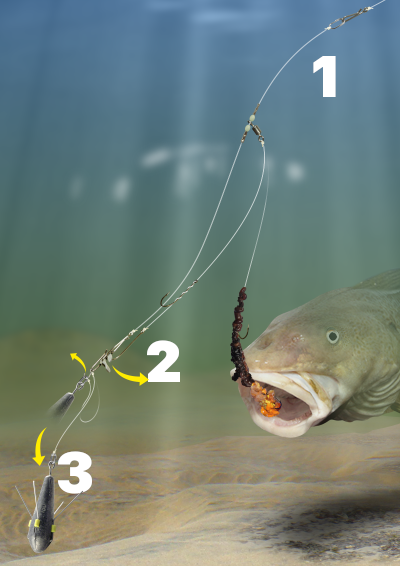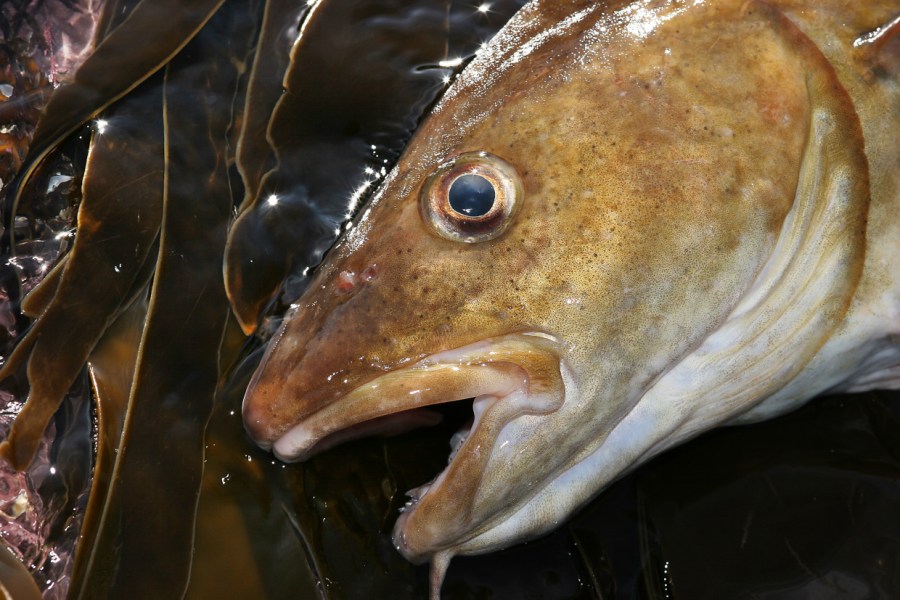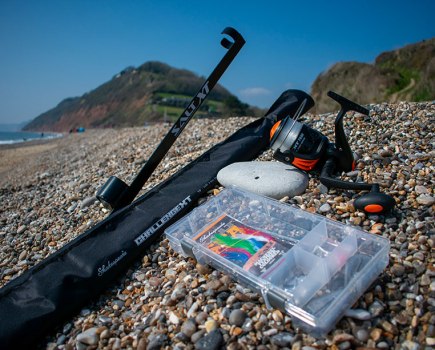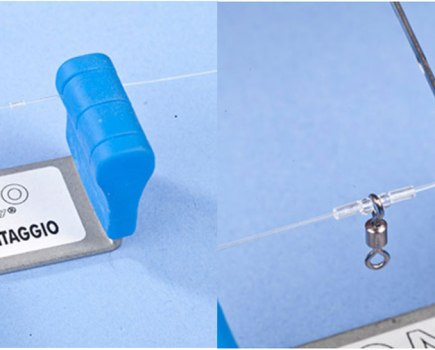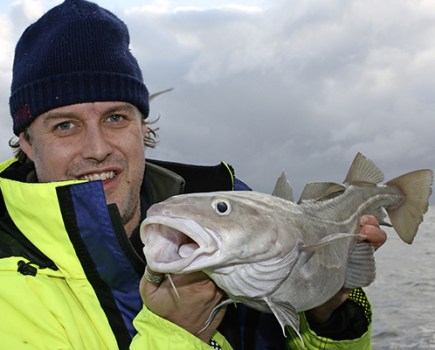Nailing your cod fishing rigs when shore fishing is a must, with the target species being caught from so many types of venue, it’s a priority that you know what is the best sea fishing rig to use for cod
For this reason Sea Angler have put together this handy little list of all the sea fishing rigs that you will need for this popular species, depending on whether distance casting is required or the fish are close in among the kelp tangles.
Take a look as we suggest some of the best cod fishing rigs, ranging from simple paternosters carrying two hooklengths for codling to the more robust single-hook rig or the popular pulley.
Want to see more about catching cod? then check out our outing with the team from Shakespeare here
1) Cod Fishing Pulley Rig
If there is one cod fishing rig that reigns supreme over really rough ground and kelp, it must be the pulley, with a paternoster rig another option.
When using a pulley, the hooklength can be clipped on the Impact Lead or similar device, such as an Imp, Gemini Splashdown Solo or Genie Rig Clip, making it streamlined for a bit of extra distance.
If you are lobbing the bait at short range, you can dispense with the Impact device and use a standard sinker with breakout wires. The wired lead weight holds your rig in place in the tide, which is a definite requirement in a rough sea.
When a fish is hooked and moves off with the bait, the rig becomes a flowing trace with the lead weight at the front and the hooked fish trailing behind.
This reduces the chance of the sinker snagging, which can be the case when using a traditional paternoster rig where the hooklength is tied to a swivel fixed on the main rig body line.
You can fish the pulley rig with a single hook (below top) or, with two hooks in tandem, which is known as a Pennell
Hook type is also important because of the increased risk of getting snagged in the rough ground or kelp. A Viking pattern or uptide style in size 3/0 and 4/0 is a good starting point, but you may prefer to go a bit bigger.
The main body of this rig should be made with 60lb-80lb mono, running through a pulley bead or pulley swivel, ending in a small bead and swivel.
The hooklength, which can be 40lb-50lb mono, ties to the swivel. The other end has a link clip for connecting the lead weight.
- On the rise – After the fish pulls out the grip wires, the rig rises off the seabed.
- Connection point – A swivel connects the 60-80lb rig body to 40-50lb hooklength.
- Bead or swivel – The pulley bead or pulley swivel connects to your shockleader.
- Rig bottom- The bottom of the rig body has a bead and then the link clip.
- Sinker choice – A grip weight holds the rig in place until a fish breaks out of the wires.
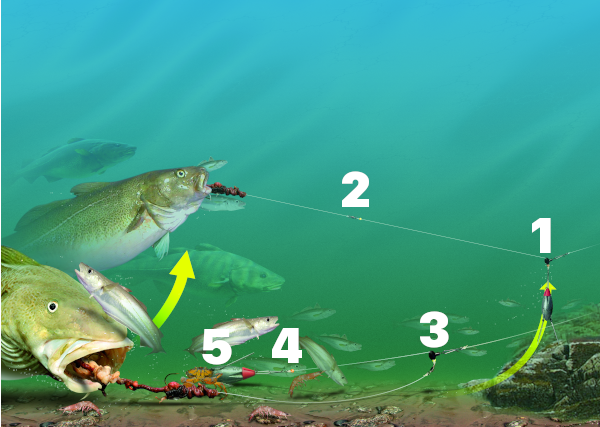
2) Pennell Paternoster for Cod fishing
A paternoster is the standard set-up for most shore rigs and can feature anything from one to three hooklengths, which are tied to swivels fixed at intervals on the rig body.
The sea fishing rig body should be 60lb line, with a hooklength ranging from 25lb-35lb to suit the terrain being fished.
The single snood version is a common choice of cod anglers because it will handle both the codling under 6lb and the bigger cod.
In this version the Pennell set-up has the top hook secured between two rubber stop beads or stop knots. Hook size can be size 3/0 or 4/0 or slightly bigger if preferred.
Position the snood swivel on the rig body to suit the length of your hook snood. Add a swivel to the top of rig to connect it to the clip on your shockleader.
- Backbone – The main rig body should be 60lb mono
- Position – Beads and crimps hold swivel in place.
- Line Rating – The snood can be 25-30lb mono line.
- Hook Trick – Use an offset hook at top of the Pennell.
- Impact Time – Sinker hits water and hook falls off.
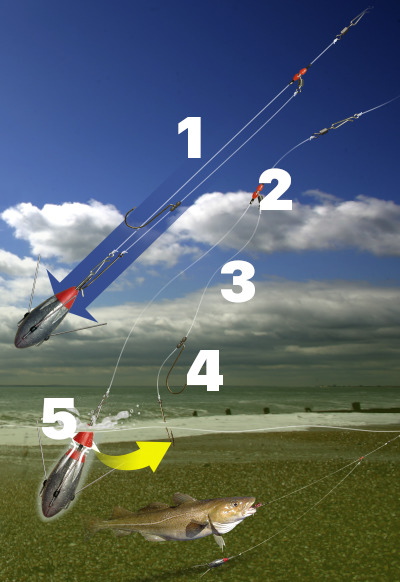
3) Two-hook peternoster for cod fishing
This is another verison of the standard paternoster, but with two hooklengths to carry more bait. It is an ideal cod fishing rig, especially if you’re targeting codling
The top hook clips to a Cascade swivel on the lower hooklength. Tension for the top hook is provided by an SRT spring under the bead and swivel.
- Add tension – The SRT held by beads and a stop knot.
- Off it goes – Top hook falls away from the Cascade.
- Off it goes – Top hook falls away from the Cascade.
- Baiting choices – Using two hook snoods means you can offer a different bait on each.
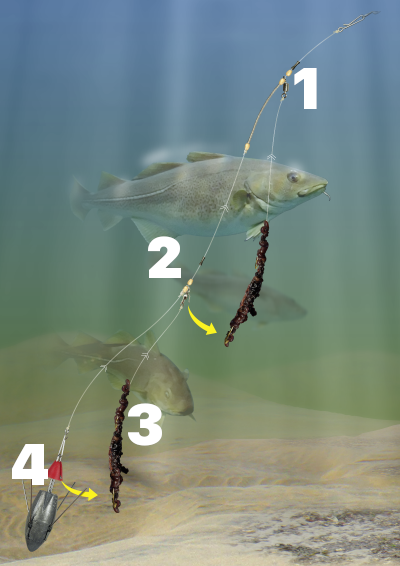
4) Loop rig for cod
A favourite among match anglers, this is a streamlined two-hook rig. By clipping two baits line astern you can achieve bigger casting distances.
The long snood at the bottom has a Cascade swivel at its mid point that clips up on the top hook. It is a variation of the
one-up, one-down rig.
- Rig holder – The link clip on leader holds the rig swivel.
- Hook to cascade – Top hook fits in the Cascade swivel fitted into the lower snood.
- Lower snood – The clipped up lower snood forms a loop to prevent trailing line.
- Clip down – Lower hook clips to Impact lead or similar
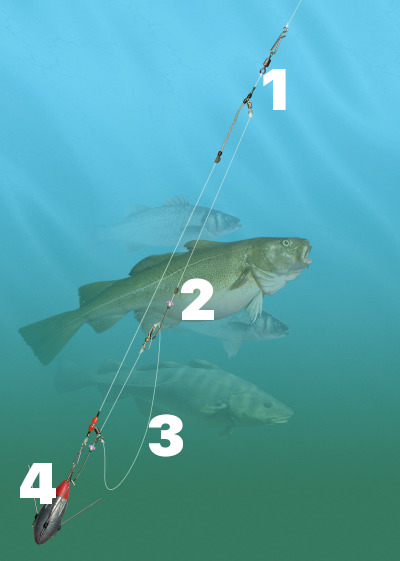
5) Pennell pulley rig for cod fishing
We’ve shown you the pulley but Nothing beats the Pennell for large cod baits, such as a lug/squid cocktail, whole squid or a fat parcel of cart (made with the coral of female edible crabs). The two hooks mean you have one at each end of your bait.
- Secure top hook – Top hook is held in place by wrapping the line around it.
- Adjust for bait size – The top hook can be moved up the snood to hold a bigger bait.
- Clip for cast – Lower hook of Pennell fits on sinker or clip.
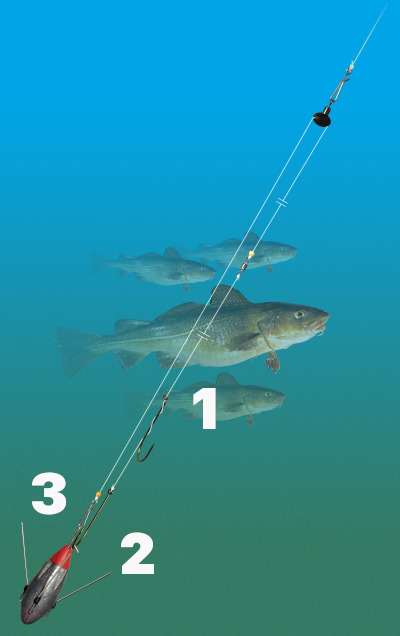
6) Rotten Bottom rig for cod
It is inevitable when fishing in rough ground that your sinker may get hung up in rocks or weed. A solution is a weak link, known as a rotten bottom.
A length of line, say 10lb, is tied to the lead link and the lead weight. Various rotten-bottom clips are available, which release line on impact with the water.
- Link system – Leader clip joins to rig’s clip or swivel.
- Ready to cast – Sinker hangs on rotten-bottom clip ready for casting out.
- Release on impact – The weaker line is released from clip on impact with the water.
